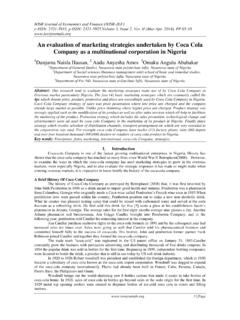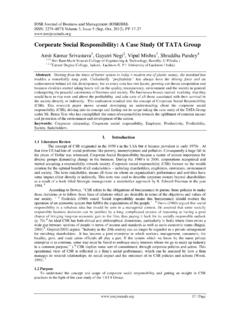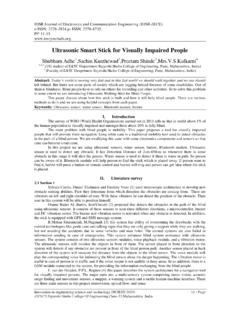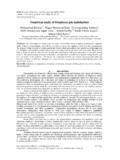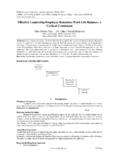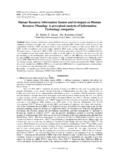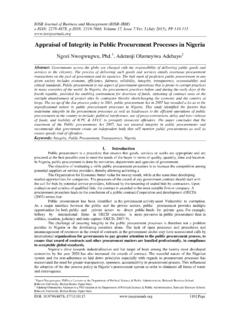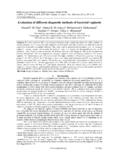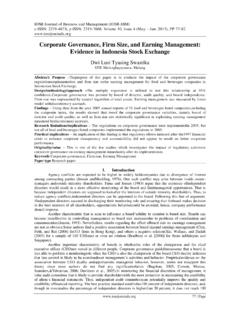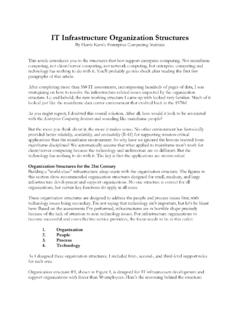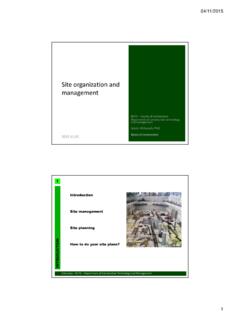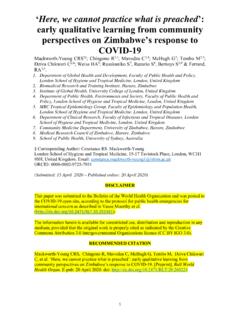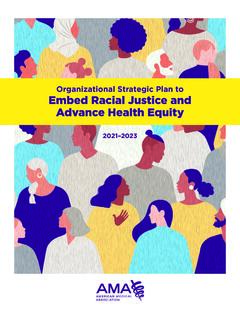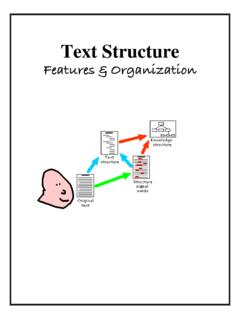Transcription of Resistance to Change in an Organization
1 IOSR Journal of Business and Management (IOSR-JBM) e-ISSN: 2278-487X, p-ISSN: 2319-7668. Volume 20, Issue 5. Ver. VII. (May. 2018), PP 37-43 DOI: 37 | Page Resistance to Change in an Organization Palakh Jain1, Chavi Asrani2,Tinu Jain3 1 Assistant Professor, Bennett University. 2 Phd Scholar, IIT-Delhi, 3 Assistant Professor, IIM-Jammu Corresponding Author: Chavi Asrani Abstract: This paper examines the widely documented literature on Resistance to Change in an organizational framework. Premise being that changes are resisted by organizations which hinders adaptation and progress in the long run. It is proposed that the same must be reduced to enhance the efficiency of Organization . The build up to this paper has been in terms of reviewing the available literature on Resistance to Change in an Organization and their major sources.
2 The unit of analysis in the paper is Organization . However, the individual and group dynamics of employees within the Organization are identified as the key tools for diminishing Resistance to Change in any organisation. Some possible pathways have been identified to achieve the same. The first pertains to devising a mechanism such that all employees are aligned towards the goal. The second pathway is to increase the participation of employees to reduce Resistance . Here, it is suggested that the Change agent should look at the entire exercise of reducing Resistance as a cost benefit analysis. Further, for empirical validation, an econometric model is formulated which suggests how diminishing Resistance over time can lead to better efficiency in an Organization . ---------------------------------------- ---------------------------------------- ---------------------------------------- --------------- Date of Submission: 11-05-2018 Date of acceptance: 26-05-2018 ---------------------------------------- ---------------------------------------- ---------------------------------------- --------------- I.
3 Defining Resistance To Change Resistance to Change is a term used either diagnostically or pejoratively, to describe a person who for some reason or another is perceived as needing to adapt their views or conduct in certain areas, often at the suggestion or requirement of an authority figure, senior manager or advisor, but is seemingly unable or unwilling to do so. Alvin Zander (1950) an early researcher on the subject, defined Resistance to Change as "behavior which is intended to protect an individual from the effects of real or imagined Change (cited in Dent & Goldberg, 1999, p. 34). Zaltman & Duncan (1977) define Resistance as "any conduct that serves to maintain the status quo in the face of pressure to alter the status quo" (cited in Bradley, 2000, p. 76). In the view of Folger & Skarlicki (1999) Resistance is defined as "employee behavior that seeks to challenge, disrupt, or invert Prevailing assumptions, discourses, and power relations" ( ) Piderit (2000) believes that the definition of the term Resistance must incorporate a much broader scope.
4 She states that "a review of past empirical research reveals three different emphases in conceptualizations of Resistance : as a cognitive state, as an emotional state, and as a behavior" (p. 784) II. Resistance To Change In Organizations Organizations by their very nature are resistant to Change and conservative in adapting changes. Government agencies want to continue doing what they have been doing for years. The majority of business firms, too, appear highly resistant to Change . The natural propensity for individuals and organizations to "defend the status quo" presents a set of challenges that management must overcome in order to bring about desired Change . According to L. Robbins (p. 545) there are six major sources of organizational Resistance Structural Inertia , Limited Focus of Change , Group Inertia , Threat to expertise , Threats to - Expertise , established Power Relationships and to established Resource Allocations.
5 Low tolerance for Change is defined as the fear that one will not be able to develop new skills and behaviors that are required in a new work setting. According to Kotter and Schlesinger (1979), if an employee has a low tolerance for Change , the increased ambiguity that results as a result of having to perform their job differently would likely cause a Resistance to the new way of doing things. An employee may understand that a Change is needed, but may be emotionally unable to make the transition and resist for reasons they may not consciously understand. The first known published reference to research on Resistance to Change in organizations was a 1948 study conducted by Lester Coch and John R. P. French entitled, "Overcoming Resistance to Change ." Their Resistance To Change In An Organization DOI: 38 | Page research generated a large body of work on the importance of employee involvement in decision making.
6 This study focused on the main questions (1) Why people resist Change so strongly (2) What can be done to overcome this Resistance ? Folger & Skarlicki (1995) investigated Resistance to Change as a response to the treatment employees receive in the Change process. Specifically they focus on resentment-based Resistance -reactions by disgruntled employees regarding the perceived unfairness of the Change . They claim that "resent-based Resistance behaviors, which can range from subtle acts of non-cooperation to industrial sabotage, are often seen by the perpetrators as subjectively justifiable - a way to "get even" for perceived mistreatment and a way for employees to exercise their power to restore perceived injustice" (p. 36). Employees resist Change because they have to learn something new. In many case there is not a disagreement with the benefits of the new process, but rather a fear of the unknown future and about their ability to adapt to it.
7 De Jag er (2001) argues, 'Most people are reluctant to leave the familiar behind. We are all suspicious about the unfamiliar; we are naturally concerned about how we will get from the old to the new, especially if it involves learning something new and risking failure" (p. 24). Positive Resistance : Managers often perceive Resistance negatively, and employees who resist are viewed as disobedient and obstacles the Organization must overcome in order to achieve the new goals. However in certain instances, employee Resistance may play a positive and useful role in organizational Change . Insightful and well-intended debate, criticism, or disagreement do not necessarily equate to negative Resistance , but rather may be intended to produce better understanding as well as additional options and solutions. de Jager (2001) claims, "the idea that anyone who questions the need for Change has an attitude problem is simply wrong, not only because it discounts past achievements, but also because it makes us vulnerable to indiscriminate and ill-advised Change ' ( ).
8 Piderit (2000) points out that what some managers may perceive as disrespectful or unfounded Resistance to Change might be motivated by an individual's ethical principles or by their desire to protect what they feel is the best interests of the Organization . Employee Resistance may force management to rethink or reevaluate a proposed Change initiative. It also can act as a as a gateway or filter, which can help organizations select from all possible changes the one that is most appropriate to the current situation. According to de Jager (2001), " Resistance is simply a very effective, very powerful, very useful survival mechanism' ' (p. 26). Employee Resistance to Change is a complex issue facing management in the complex and ever-evolving Organization of today. The process of Change is ubiquitous, and employee Resistance has been identified as a critically important contributor to the failure of many well-intend and well-conceived efforts to initiate Change within the Organization .
9 Individual sources of Resistance to Change reside in basic human characteristics such as perceptions, personalities, and parochial self interests. Managing Organizational Change There are several well-known approaches to managing Change : Lewin s Classic three-step model , action research , Organization development , etc. (Robbins - p. 551) Beckhard and Pritchard (1992) have outlined the basic steps in managing a transition to a new system: Identifying tasks to be done, creating necessary management structures, developing strategies for building commitment, designing mechanisms to communicate the Change , and assigning resources. Task identification would include a study of present conditions (assessing current reality, as described above); assessing readiness, such as through a force field analysis; creating a model of the desired state, in this case, implementation of the Change ; announcing the Change goals to the Organization ; and assigning responsibilities and resources.
10 This final step would include securing outside consultation and training and assigning someone within the Organization to oversee the effort. This should be a responsibility of top management. In fact, the next step, designing transition management structures, is also a responsibility of top management. In fact, Cohen and Brand (1993) and Hyde (1992) assert that management must be heavily involved as leaders rather than relying on a separate staff person or function to shepherd the effort. An Organization wide steering committee to oversee the effort may be appropriate in developing commitment strategies. To communicate the Change , mechanisms beyond existing processes will need to be developed. Special all-staff meetings attended by executives, sometimes designed as input or dialog sessions, may be used to kick off the process, and newsletters may be an effective ongoing communication tool to keep employees aware of activities and accomplishments.

